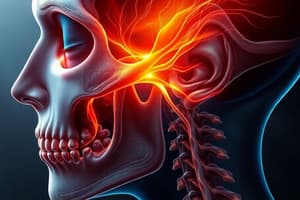Podcast
Questions and Answers
Which of the following statements about pituitary adenylate cyclase-activating polypeptide (PACAP) is correct based on the information provided?
Which of the following statements about pituitary adenylate cyclase-activating polypeptide (PACAP) is correct based on the information provided?
- PACAP can induce activation of neurons in regions thought to be involved in cluster headache pathophysiology, such as the superior salivatory nucleus, the sphenopalatine ganglion, and the trigeminal ganglion. (correct)
- Intravenous administration of PACAP in healthy individuals can induce cluster headache-like symptoms.
- PACAP is pharmacologically similar to VIP and has been implicated in migraine pathogenesis, but not in cluster headache.
- PACAP levels have been found to be increased in plasma during acute cluster headache attacks.
According to the information provided, which of the following statements about the effects of methylprednisolone on cluster headache pathophysiology is correct?
According to the information provided, which of the following statements about the effects of methylprednisolone on cluster headache pathophysiology is correct?
- Methylprednisolone can suppress both IL-1β and prostaglandin E2-induced CGRP release from cultured trigeminal ganglia neurons.
- Pretreatment with methylprednisolone can block cytokine-mediated trigeminal activation, which may mediate its preventive effect on cluster headache pathophysiology. (correct)
- Methylprednisolone has been shown to have no effect on CGRP release from trigeminal ganglia neurons, but it can reduce plasma CGRP levels in cluster headache patients.
- The mechanism by which methylprednisolone exerts its preventive effect on cluster headache pathophysiology is not related to its effects on trigeminal ganglia neurons or CGRP release.
Based on the evidence presented, which of the following statements is most accurate regarding the role of the trigeminal nerve in cluster headache?
Based on the evidence presented, which of the following statements is most accurate regarding the role of the trigeminal nerve in cluster headache?
- Increased levels of calcitonin gene-related peptide (CGRP) and vasoactive intestinal peptide (VIP) suggest trigeminal nerve and parasympathetic activation, respectively, during cluster headache attacks.
- Surgical lesioning of the trigeminal nerve is effective in treating cluster headache, indicating a central role.
- While the trigeminal nerve is involved in cluster headache, its activation alone cannot fully account for the disorder, and other factors are likely involved. (correct)
- Pretreatment with methylprednisolone can suppress CGRP release from trigeminal ganglia neurons, suggesting a direct effect on the trigeminal nerve.
Which of the following statements about calcitonin gene-related peptide (CGRP) is incorrect based on the information provided?
Which of the following statements about calcitonin gene-related peptide (CGRP) is incorrect based on the information provided?
Based on the information provided, which of the following statements about the relationship between cluster headache and migraine is correct?
Based on the information provided, which of the following statements about the relationship between cluster headache and migraine is correct?
According to the trigeminal nerve model of cluster headache, what mechanism leads to the autonomic symptoms observed in patients?
According to the trigeminal nerve model of cluster headache, what mechanism leads to the autonomic symptoms observed in patients?
Which statement best describes the role of triptans in the treatment of acute cluster headache attacks according to the information provided?
Which statement best describes the role of triptans in the treatment of acute cluster headache attacks according to the information provided?
What is the primary controversy regarding the mechanism of action of triptans in the treatment of cluster headache according to the information provided?
What is the primary controversy regarding the mechanism of action of triptans in the treatment of cluster headache according to the information provided?
Based on the information provided, which of the following statements about the role of calcitonin gene-related peptide (CGRP) in cluster headache is most accurate?
Based on the information provided, which of the following statements about the role of calcitonin gene-related peptide (CGRP) in cluster headache is most accurate?
What is the key evidence provided in the text that supports the trigeminal nerve model of cluster headache?
What is the key evidence provided in the text that supports the trigeminal nerve model of cluster headache?
What evidence suggests that the success of sumatriptan treatment in cluster headache may be due to central effects on the trigeminal nucleus caudalis?
What evidence suggests that the success of sumatriptan treatment in cluster headache may be due to central effects on the trigeminal nucleus caudalis?
Which neuropeptide is similar to VIP and has been implicated in migraine pathogenesis, inducing migraine-like headaches when administered intravenously?
Which neuropeptide is similar to VIP and has been implicated in migraine pathogenesis, inducing migraine-like headaches when administered intravenously?
What is a marker of parasympathetic activation that is elevated in jugular vein blood samples ipsilateral to cluster headache attacks?
What is a marker of parasympathetic activation that is elevated in jugular vein blood samples ipsilateral to cluster headache attacks?
Which finding supports the involvement of PACAP in cluster headache pathophysiology?
Which finding supports the involvement of PACAP in cluster headache pathophysiology?
What can be attenuated by sumatriptan injection in patients during nitroglycerine-induced attacks?
What can be attenuated by sumatriptan injection in patients during nitroglycerine-induced attacks?
Flashcards are hidden until you start studying




